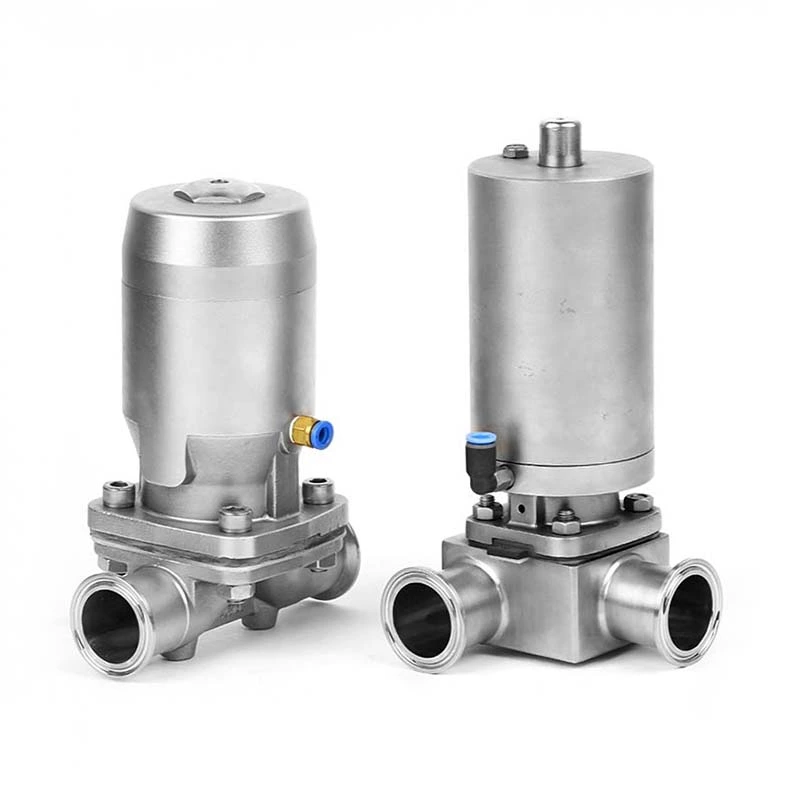Sanitary Diaphragm Valve Equipment Process Principle
Sanitary Diaphragm Valve, as an important flow control device, are widely used in industries such as chemical, pharmaceutical, and food. Sanitary diaphragm valves play a crucial role in these industries, ensuring hygienic standards during production. This article will explain the process principles of sanitary diaphragm valves.
1. Basic Structure of Diaphragm Valves
A diaphragm valve is a flow control device consisting of a valve body, diaphragm, piston, and spring. A diaphragm is located within the valve body, a stem connects the piston and diaphragm, and a spring controls the position of the piston and stem. When the medium passes through the valve, the diaphragm opens or closes in response to the movement of the stem, thereby controlling the flow rate.
Sanitary diaphragm valves feature improvements in their basic structure, primarily in the following aspects:
1. Body Material
The body of a sanitary diaphragm valve is constructed of stainless steel, with a polished, residue-free surface. The interior of the valve body is polished and cleaned to ensure product hygiene.
2. Stem Material
The stem of a sanitary diaphragm valve is also constructed of stainless steel, with a smooth surface free of roughness and scratches. The stem connects the piston and diaphragm, transmitting force. 3. Diaphragm Material
The diaphragm of a sanitary diaphragm valve is made of food-grade materials such as fluororubber and butyl rubber, offering excellent acid, alkali, and corrosion resistance.
4. Piston Structure
The piston and diaphragm of a sanitary diaphragm valve are tightly integrated to reduce the impact of operating forces on the diaphragm, thereby improving the valve's sanitary standards.
II. Process Principle of Sanitary Diaphragm Valves
In sanitary applications, diaphragm valves not only require high hygiene standards but also excellent fluid control capabilities. The process principles of sanitary diaphragm valves primarily encompass the following aspects:
1. Fluid Continuity
Sanitary diaphragm valves require that the medium flow through the valve without dead spots, blockages, or accumulation during operation, ensuring fluid continuity. The tight integration of the piston structure and diaphragm effectively reduces pressure fluctuations and oscillations during fluid control.
2. Fluid Leakage
A key feature of diaphragm valves is that the diaphragm controls the flow of the medium, preventing leakage. In sanitary diaphragm valves, the quality, thickness, and material of the diaphragm all have a significant impact on leakage, necessitating the selection of high-quality raw materials, meticulous testing, and processing.
3. Cleaning and Hygiene
Sanitary diaphragm valves require frequent cleaning and disinfection during use to ensure product hygiene standards. Cleaning methods include manual, automatic, and CIP, and the selection should be tailored to the specific conditions of use. During the cleaning process, care must be taken to protect key components such as the diaphragm and piston to prevent damage.
4. Adaptability to the Medium
Sanitary diaphragm valves are commonly used to transport a variety of media, requiring a thorough understanding of the media's characteristics to select the appropriate diaphragm material. During use, it is important to monitor changes in the media's properties and make timely adjustments to ensure product stability.
III. Use and Maintenance of Sanitary Diaphragm Valves
The following aspects require careful attention during the use of sanitary diaphragm valves:
1. Proper Installation
When installing a sanitary diaphragm valve, follow the valve's application instructions and usage requirements, paying attention to the valve's orientation, position, and connection method to avoid problems caused by improper installation. 2. Normal Operation
During normal use, the valve's opening and closing must be coordinated appropriately based on factors such as media pressure and temperature to avoid damage to critical components such as the diaphragm due to improper operation.
3. Regular Maintenance
Sanitary diaphragm valves require regular maintenance and inspection to ensure they are in good condition. Maintenance primarily includes cleaning, lubrication, inspection, and replacement.
4. Maintenance and Cleaning
During use, the valve must be kept clean and hygienic to prevent contamination from media, dust, and other contaminants that could affect product quality.
IV. Summary
Sanitary diaphragm valves, as an important flow control device, are widely used in the sanitary industry. The process principles of sanitary diaphragm valves primarily encompass fluid continuity, fluid leakage, cleaning and sanitation, and media compatibility, requiring selection and adjustment based on specific application conditions. Proper use and maintenance of sanitary diaphragm valves ensure product stability and production efficiency.
